Abstract
Abstract 362
Delayed engraftment and low rates of platelet transfusion independence are frequently observed after CB transplantation (CBT). We conducted a study of ex-vivo co-culture of CB mononuclear cells with either third party haploidentical family member marrow derived MSCs (N=8) or off-the-shelf mesenchymal progenitor cells (MPCs) from Angioblast (N=24). Patients received a double cord blood transplant, with one of the 2 units undergoing ex vivo expansion using this system. MSCs create a microenvironment that promotes expansion and fosters the differentiation of hematopoietic cells. Patients must have had two CB units matched in at least 4/6 HLA antigens, with a minimum of 1×107 TNC/Kg per unit.
Diagnoses were AML/MDS (n=21), ALL (n=6), NHL (n=2), CLL (n=2), and HD (n=1). Fourteen patients (44%) were in CR (CR1, n=3, CR2 or more, n=11) and 18 (56%) had active disease at CBT. Preparative regimen: myeloablative fludarabine, melphalan, thiotepa and ATG (n=32), with rituximab in the 4 NHL/CLL cases. GVHD prophylaxis: tacrolimus and MMF. Median weight was 75.2 Kg (range, 15–118) and median age was 35.3 years (2.8-62 years). Donor-recipient HLA matching was 6 of 6 in 5%, 5 of 6 in 28% and 4 of 6 in 67% of the cases, respectively.
Ex-vivo EXP: 100 ml of marrow was aspirated from the family donor and MSCs generated in ten T175 flasks, which took ∼21 days (n=8) or one vial of Angioblast MPCs was thawed and expanded to confluence in 10 flasks within 4 days (n=24). The CB unit with the lowest TNC dose was then thawed, divided into 10 fractions, and each placed into 1 flask containing the confluent layers of MSCs in expansion media with SCF, FLT3-ligand, G-CSF and TPO. After 7 days at 37°C, the non-adherent cells were removed from each flask, placed into each of ten one-liter Teflon-coated culture bags (American Fluoroseal) and cultured for an additional 7 days (14 days total), while 50 ml of media/growth factors was added to the flasks to culture the remaining adherent layer during that time period. On day 14 the cells from the bags and the flasks were combined, washed and infused along with a second unmanipulated CB unit.
The median number of total nucleated cell (TNC) and CD34+ cells infused/Kg in unmanipulated CB was 2.35 × 107 (range 0.2–8.2) and 0.95 × 105 (range 0–4). The median number of TNC and CD34+ cells infused/Kg after EXP was 5.8 × 107 (range, 0.3–14.4) and 8.7 × 105 (range, 0–93.4). This represented a median expansion of 14-fold (range 1–30) for TNC and 40-fold (range 4–140) for the CD34+ cells. Median time to neutrophil and platelet engraftment was 15 days (range 9–42) and 40 days (range 13–62). There were no toxicities attributable to the EXP cells. Thirty-one (97%) and 26 (81%) of all patients engrafted neutrophils and platelets, respectively. One patient died before engraftment. Thirty and one-hundred day non-relapse mortality is respectively 6% and 19%. Median donor(s) chimerism was 100% in the mononuclear, T lymphocyte and myeloid cell populations. On transplant day+21, EXP unit contributed with a mean of 19% of mononuclear cell, 16% of T cell, and 14% of myeloid chimerism. Subsequently, hematopoiesis was increasingly derived from the unexpanded unit with long-term engraftment provided by the unexpanded unit by six months posttransplant.
Acute grade II-IV and III-IV GVHD rate was 50% and 16%; 25% of the grade II-IV GVHDs occurred beyond 100 days, and two patients developed chronic GVHD. With a median follow-up of 9 months, 11 patients are alive; actuarial one-year survival is 40%. Mortality was due to relapse in 26% and non-relapse causes in 74% of patients.
MSC-CB Exp is feasible and leads to fast engraftment of neutrophils and platelets, and high-rates of platelet transfusion independence.
No relevant conflicts of interest to declare.

This icon denotes an abstract that is clinically relevant.
Author notes
Asterisk with author names denotes non-ASH members.

This feature is available to Subscribers Only
Sign In or Create an Account Close Modal